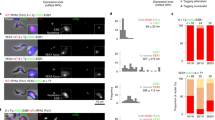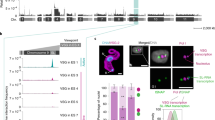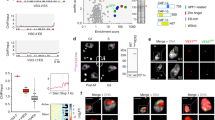Abstract
African trypanosomes are thought to evade the host immune system by periodically changing their variable surface glycoprotein (VSG). VSG genes are activated by a complex process involving the duplicative transposition of silent basic copy genes to one of several expression sites1–3. These expression-linked copies (ELCs) of the VSG genes are also subject to regulation within expression sites by as yet unknown mechanisms4–9. It is generally assumed that trypanosomes can express only one VSG gene at a time. Nevertheless, the finding that they contain multiple VSG gene expression sites suggests that multiple expression is possible. We show here that Trypanosoma equiperdum can stably express two VSG genes in a simple axenic culture system10 and that both antigens are present on the cell surface. The two antigens do not co-cap or form heterodimers. Their corresponding genes show no cross-hybridization and are situated in different telomere-linked expression sites. Northern blot analysis reveals that both genes are active in the double expressors.
This is a preview of subscription content, access via your institution
Access options
Subscribe to this journal
Receive 51 print issues and online access
$199.00 per year
only $3.90 per issue
Buy this article
- Purchase on Springer Link
- Instant access to full article PDF
Prices may be subject to local taxes which are calculated during checkout
Similar content being viewed by others
References
Longacre, S. et al. Molec. cell. Biol. 3, 399–409 (1983).
Pays, E., Lheureux, M. & Steinert, M. Nature 292, 265–267 (1981).
Hoeijmakers, J. H. J., Frasch, A., Bernards, A., Borst, P. & Cross, G. A. M. Nature 284, 78–80 (1980).
Young, J. R., Miller, E., Williams, R. O. & Turner, M. J. Nature 306, 196–198 (1983).
Buck, G. et al. Nature 307, 563–566 (1984).
Bernards, A. et al. Cell 36, 163–170 (1984).
Buck, G., Jacquemot, C., Baltz, T. & Eisen, H. Gene 32, 329–336 (1984).
Laurent, M. et al. Nucleic Acids Res. 12, 8319–8328 (1984).
Myler, P. J., Allison, J., Agabian, N. & Stewart, K. Cell 39, 302–211 (1984).
Baltz, T., Baltz, D., Giroud, C. & Crockett, J. EMBO J. 4, 1273–1277 (1985).
Capbern, A., Giroud, C., Baltz, T. & Mattern, P. Expl Parasit. 42, 6–13 (1977).
Esser, K. M., Schoenbechler, M. J. & Gingrich, J. B. J. Immun. 129, 1715–1717 (1982).
Auffet, C. A. & Turner, M. G. Biochem. J. 193, 647–650 (1981).
Baltz, I., Baltz, D. & Pautrizel, R. Annls Immun. Inst. Pasteur, Paris 127C, 761–774 (1976).
Young, J. R., Donelson, J. E., Majiwa, P. A. O., Shapiro, S. & Williams, R. O. Nucleic Acids Res. 10, 6581–6595 (1982).
Saunders, G. C. Immunoassays in the Clinical Laboratory, 99–118 (Liss, New York, 1979).
Author information
Authors and Affiliations
Rights and permissions
About this article
Cite this article
Baltz, T., Giroud, C., Baltz, D. et al. Stable expression of two variable surface glycoproteins by cloned Trypanosoma equiperdum. Nature 319, 602–604 (1986). https://doi.org/10.1038/319602a0
Received:
Accepted:
Issue Date:
DOI: https://doi.org/10.1038/319602a0
This article is cited by
Comments
By submitting a comment you agree to abide by our Terms and Community Guidelines. If you find something abusive or that does not comply with our terms or guidelines please flag it as inappropriate.



